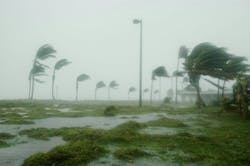Storm Warnings
As this issue goes to press, Hurricane Jose is still swirling around out in the Atlantic making threatening gestures at the northeastern U.S., and Hurricane Maria and what’s currently called “potential tropical cyclone 15” are gathering strength out beyond the Leeward Islands. Some meteorologists think both of them have the potential to do some serious damage to the Caribbean, Florida, and the East Coast.
2017 has definitely been above-normal for major weather events: The National Oceanic and Atmospheric Administration (NOAA) predicts that there will be a total of 14 to 19 named storms between June and November this year, the most active season since 2010. But neither this year, nor 2010, matches 2005, which saw 28 named storms during the season, among them Category 4 and 5 hurricanes Dennis, Emily, Katrina, Rita, and Wilma, with Wilma being the most intense hurricane ever recorded in the Atlantic.
This year’s storms are different, though. Harvey is being called the “wettest tropical hurricane on record in the contiguous United States.” The qualifier is due to Hurricane Hiki, which dropped 52 inches of rain on the mountains of Hawaii in 1950—.12 inches more than Houston received from Harvey. Unlike Hawaii, though, where Hiki caused 200 residents to flee their homes and about $200,000, in 1950 dollars, in damages were reported, Harvey’s devastation is historic as well. ABC News compiled the following statistics: Harvey dumped more than 20 trillion gallons of water on Texas and Louisiana, enough to supply New York City for more than 50 years; damaged or destroyed 185,149 homes, according to the Texas Division of Emergency Management; and may have caused $125 to $190 billion in losses in Texas alone.
Hurricane Irma, notable for its strength and longevity, is estimated to have caused $100 billion more in damages in the U.S. The Florida Keys suffered the brunt of that storm, taking a direct hit on its Atlantic side. Commercial and residential buildings and the infrastructure in the Keys sustained heavy casualties that will take years to clean up and repair. Believe it or not, it could have been worse. It appears that Florida’s strict building codes, designed to allow houses to withstand the fiercest of storms, were actually up to the challenge. The codes, put into place as a result of the punishment inflicted on Florida in 1992 by Hurricane Andrew, are the toughest in the country. And the regulations in Monroe and Miami-Dade counties are stricter yet. Preliminary inspection of the storm-ravaged areas has shown that many of the houses built to these codes have performed as hoped.
Houston had no such upside. Its building codes were inadequate at best. Its miles and miles of pavement prevented the absorption of the rainfall into the ground. And its reservoirs could not begin to capture enough water. According to the online publication Grist, the city has made a stab at creating a fund to expand its drainage system by “taxing landowners $3 for every 1,000 square feet of shingles and pavement that sheds water from their properties into the sewers.” It’s not clear that this will be a viable solution, however, as Houston hasn’t provided a place for the stormwater to go.
It is clear that something needs to be done and now is the time to do it, while the need is still fresh in everyone’s minds. The people of Houston and their representatives must try to learn how to prevent as much of the flooding as they can, whether through retention ponds or other methods, and attempt to avoid the pain and suffering that will come with future events like Harvey.
Florida has made some headway in this regard with its building codes and, while there is no doubt preventive measures will be expensive for Houston’s builders and homeowners and the jurisdictions in which they reside, the billions that will be spent on recovery after Harvey could have gone a long way toward preventing much of the damage

